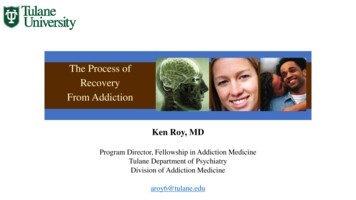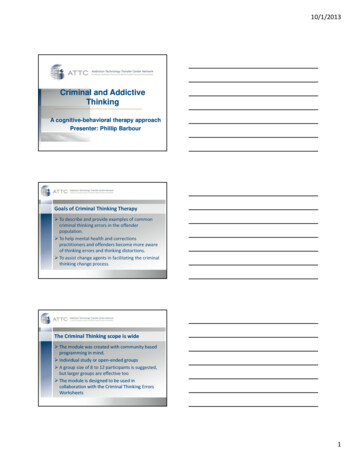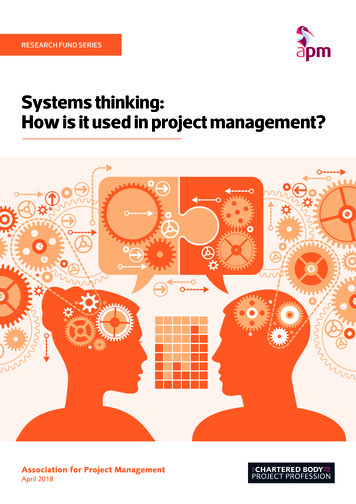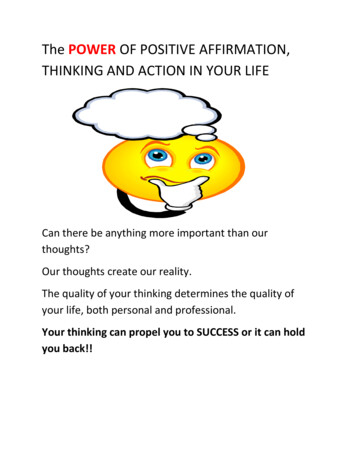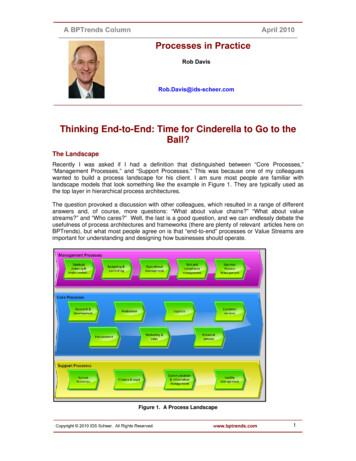
Transcription
Thinking End-to-End: Time for Cinderella to Go to theBall?The LandscapeRecently I was asked if I had a definition that distinguished between “Core Processes,”“Management Processes,” and “Support Processes.” This was because one of my colleagueswanted to build a process landscape for his client. I am sure most people are familiar withlandscape models that look something like the example in Figure 1. They are typically used asthe top layer in hierarchical process architectures.The question provoked a discussion with other colleagues, which resulted in a range of differentanswers and, of course, more questions: “What about value chains?” “What about valuestreams?” and “Who cares?” Well, the last is a good question, and we can endlessly debate theusefulness of process architectures and frameworks (there are plenty of relevant articles here onBPTrends), but what most people agree on is that “end-to-end” processes or Value Streams areimportant for understanding and designing how businesses should operate.Figure 1. A Process Landscape1
The RouteSo what is an end-to-end process? Is it the same as a Value Chain or Value Stream? Typically,an end-to-end process is a chain of process steps (or subprocesses) that starts as the result of acustomer trigger and proceeds through until a successful outcome for the customer is achieved.A well-known example of an end-to-end process is “Order-to-Cash.” Here a customer contacts abusiness with the intention of placing an order for a product. This initiates a process that handlesthe placing of the order, the processing of the order, delivery (possibly manufacture), invoicing,and revenue collection. Of course, people may immediately want to debate where the “ends” inthe end-to-end process actually are. For instance, you could argue that starting the process whena customer wants to place an order misses some key sales and marketing steps. To get aroundthis, some people prefer to describe this process as “Lead-to-Cash,” which covers the wholepotential product-buying lifecycle.You can also argue that “Order-to-Cash” is a rather internally focused viewpoint. It is an “insideout” view of the world, rather than the”outside-in” approach that takes the customer’s viewpoint.However, we have to be careful here as we need to balance the needs of the customer with theneeds of the business and its stakeholders. It’s all very well taking a customer viewpoint; ofcourse, the customer is happy when they get their product, but they are not so worried aboutpaying for it! The business, on the other hand, needs to make sure that it delivers to thecustomer, but also that it gets the payment and the check doesn’t bounce. I have seen examplesof companies that were so eager to launch a new product that they didn’t put in place a processfor billing for it until several months after launch!So an end-to-end process needs to have some key characteristics: It must reflect the customer’s view of when they initiate the process and when theyget a successful outcome. It must reflect the organization’s view of when the customer interaction is completeand a business objective has been met. It must be capable of being measured, and those measures must take account of thecustomer view and the organizational view.Is an end-to-end process the same as a Value Chain or Value Stream? Well, a value chain isvery similar to an end-to-end process, but has a different viewpoint. George Brown from theValue Chain Group [1] describes a Value Chain as “a series of value-adding activities thatconnect a company’s supply side with its demand side.” In contrast, he says, “Value Streamsrelate to the value-adding activities that satisfy the need of different customer types.” By thisdefinition, Value Streams are end-to-end processes, but Value Streams only describe a subset ofthe processes that operate a business. The latest trend is to talk about Value Nets [1] that providea more collaborative approach to delivering customer value.So end-to-end processes are Value Streams, but the definition of the term “end-to-end process”is not formally defined and people may well include other processes that would not normally fitinto the Value Stream category. If that’s the case, should we stop talking about end-to-endprocesses? We may well find that over time the Value Chain Group terminology becomesubiquitous and terms like “end-to-end” fall into disuse. You can learn more about these differentdefinitions in George Brown’s article [1] and in a previous Technical Brief by Celia Wolf [2].The JourneyOf course, nothing is quite as simple as we would like. If the customer is buying a straightforwardproduct for which they make a one-off payment we can see that the process ends once cash hasbeen received. That’s cash from the bank, of course, not just the receipt of the customerpayment, because the customer or the bank may default on the payment. This illustrates animportant point about measuring the end-to-end. You must choose measures that correctly reflectthe objectives the process is trying to achieve (generating revenue) and be wary of those thatmay be of interest (delivery time) but don’t tell the whole story.2
However, what happens if it’s a more complex product where there is a monthly subscriptionattached? Does the end-to-end process include collecting all those monthly subscriptions? Well, ifit does, the process may never end, or, at the very least, it is going to be a long lasting process,which is not very useful for analysis and measurement purposes. So an obvious answer is that“Lead-to-Cash” ends once the initial payment or the first month’s subscription has been received,and that some other process looks after subsequent subscription billing. Of course, the questionis which other process? And does that process fit in a different end-to-end process? Furthermore,in some cases, “Lead-to-Cash” will deliver pre-manufactured products, while, in other cases, theproduct will be manufactured to order. So another question arises: Does “Lead-to-Cash” includemanufacturing?Despite these issues, “Lead-to-Cash” is one of the more obvious examples of an end-to-endprocess where we can connect together a sequence of subprocesses that are dedicated just to“Lead-to-Cash” (or seem to be). What other end-to-end processes might we have? Mostbusinesses also have a customer problem-handling process, which we might call “Problem-toResolution.” Here a customer contacts a call center with a problem, and a number of differentdepartments or organizations work to diagnose the problem and restore service or resolve thecustomer’s problem. This example is not so clear cut. For instance, if a customer reports aproblem with their Internet connection it could be due to a major network fault, and the resolutionof the customer’s problem could require restoration work on a substantial part of the network.This could involve processes that on the face of it seem to be more concerned with buildinginfrastructure (e.g., installing network routers, replacing cables, etc.) than resolving customerproblems. We might also call upon processes for testing the network and the customer’s product,which, when you think about it, might be the same processes that would be involved in “Lead-toCash” for testing a new product installation. If a customer orders a really complex, bespokeproduct, we may have to build additional business infrastructure to deliver it (e.g., provide more ITserver or network capacity).Figure 2. Lead-to-Cash Customer Journey3
The more we think about it, the more we see that the idea of an end-to-end process is ratherartificial. What we are in fact talking about is the “journey” (or path) through the organization’sprocess landscape or through the Value Chains. Often, these are called “customer journeys”because they are associated with delivering to the customer, but, of course, the journey that thecustomer actually experiences will be different from the journey the business follows. Swim lanemodels can be useful here to show the process journey from the business point of view alongwith the customer interactions. We can also use the BPMN concept of public and privateprocesses. The private process is the journey through the processes that the business operates,while the public process is the journey the customer experiences from the same processes.Some of the processes in the landscape may only be used in one journey, while others mayprovide business services (e.g., a product test) to several journeys. The journey will always followthe same basic pattern (see my last BPTrends column [3]), but the actual complexity of thejourney and the number of processes involved will depend on the specific circumstances.What we now see is that we can superimpose the “journeys” onto the process landscape, asshown in Figure 2. This gives us a “value view” of the business processes as we can now seewhich processes are directly concerned with delivering to customers (this is where end-to-endprocesses are very similar to Value Streams).Chicken and EggsHow many journeys are there in a business? Figure 3 gives us a simple view of three importantjourneys: “Lead-to-Cash,” “Problem-to-Resolution,” and “Concept-to-Market.” Once again, youcan have a debate about whether “Concept-to-Market” really is a customer-related journey. Itprobably wouldn’t be thought of as Value Stream, but even if the customer isn’t the direct triggerfor the journey, the journey is certainly about delivering customers’ needs, even if they don’t knowthey have those needs.Figure 3. Typical Customer JourneysIf we have the concept of a journey, and we have also seen that the process landscape is stilluseful, which do you design first – the landscape or the journey? Well, of course, the answer isyou do both together, focusing on delivering customer service and business objectives, but at thesame time creating blocks of process that can be reused. I talked about reuse in last quarter’scolumn [3], and all of the concepts I discussed are relevant here. It can be a challenge to design4
blocks of process that can be reused, but combining the customer journeys with the processlandscape highlights where there are opportunities for reuse and where the most value can begained.Time for Cinderella to go to the BallThere is a further question: Which of the customer journeys do you focus on first? The traditionalanswer is “Lead-to-Cash.” After all, this is the main process that deals with the customer andgenerates business revenue, so getting this right is clearly a priority. Next in line is “Problem-toResolution.” Once you have sold the customer a product you want to make sure that you can fix itif it goes wrong in order to keep the customer happy. Dragging up the rear is “Concept-toMarket.” It would seem that you can take a more leisurely view of this. You don’t launch newproducts every day and, anyway, it’s all about ideas and innovation – you don’t need a processfor that, do you?Well, I am sure you can see what’s coming. The best “Lead-to-Cash” process in the world is oflimited value if the next product the business launches can’t use it! How many operationaldepartments have been surprised when the marketing department announces the latest productlaunch plan and then the IT and process teams are left to try and work out how to deliver it, trainthe staff, and bill the customer? Of course, what often happens is that the standard infrastructurewon’t support the new product and can’t be modified in time, so a stand-alone “stovepipe”solution is developed. The same happens at the next product launch, and the stovepipesproliferate. At some point in the future, after things have gotten out of control, there is an initiativeto improve “Lead-to-Cash” and encourage more reuse. But this is addressing the symptoms notthe cause. The cause is the lack of an effective “Concept-to-Market” that ensures that an effective“Lead-to-Cash” infrastructure is put in place and reused.We need “Concept-to-Market” to be not just a parochial new product launch process but a holisticprocess that’s about business strategy, developing new products, and building the businessinfrastructure. The key is reuse. The roll of “Concept-to-Market” is to generate new product ideasthat meet customers’ needs, align with business strategy, and reuse the corporate infrastructure.It is also responsible for building that corporate infrastructure (for reuse) and developing andenhancing it to meet future needs. Thus, “Concept-to-Market” should not follow on after “Lead-toCash” and “Problem-to-Resolution” – it should come before them and be responsible fordesigning and delivering those processes.So “Concept-to-Market”” should no longer be the “Cinderella” that is ignored at the expense of the“Lead-to-Cash” and “Problem-to-Resolution” ugly sisters, but should actually be the mostimportant customer journey (or end-to-end process). Without an effective “Concept-to-Market”then the business will be doomed to endless stovepiped “Lead-to-Cash” processes. It’s time forthe BPM prince to take “Concept-to-Market” to the ball before midnight approaches.References[1] George Brown. Value Chains, Value Streams, Value Nets, and Value Delivery Chains. BPTrends,April, 2009[2] Celia Wolf. Technical Brief: Value Chains and Business Processes. BPTrends, November, 2003[3] Rob Davis. Process Reuse – Do We Understand What It Really Means? BPTrends, February 20105
Jun 10, 2004 · The latest trend is to talk about Value Nets [1] that provide a more collaborative approach to delivering customer value. So end-to-end processes are Value Streams, but the definition of the term “end-to-end process” is not formally defined and people may well include other processes that would not norm





